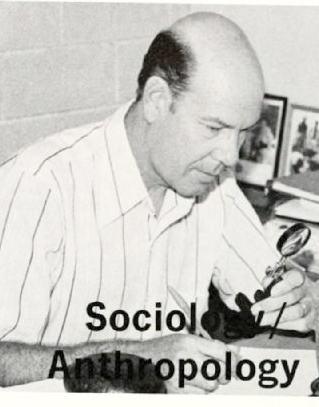
A native of Gatesville, N.C., David Sutton Phelps, Jr., joined the Department of Sociology and Anthropology in the fall of 1970 after having previously taught at Florida State University and the University of Georgia. Earlier, he had completed his Ph.D. in anthropology at Tulane University following undergraduate work at Chapel Hill. At ECU, Phelps pioneered the archaeological and anthropological exploration of eastern North Carolina, making significant discoveries of cultural sites associated with native peoples dating back, in some cases, approximately 12,000 years. He also conducted archaeological excavations of Civil War sites, and then finally, late in his career, he led digs that resulted in the discovery of important artifacts – including a widely-publicized signet ring – presumably left by one of the earliest European settlers in the area. As an engaged archaeologist, Phelps emerged as the leading force behind the founding of the ECU archaeology lab, as well as the coordinator of field studies that brought to the lab artifacts from excavation sites throughout eastern North Carolina. Following his retirement, the Anthropology Department honored Phelps by naming its archaeology lab after him.
Dr. Charles Ewen, professor of anthropology and current director of the Phelps Archaeology Laboratory, noted that of the thousands of artifacts Phelps collected in his more than 30-year career, a signet ring that Phelps’ field study team found attracted the most media attention. Ewen emphasized, however, that Phelps' field studies at the Neoheroka site in Greene County and at the Jordan's Landing site in Bertie County – two important Tuscarora sites – were also exceptionally significant for understandings of prehistoric Algonquian peoples and their early contacts with European explorers and settlers.
The signet ring was unearthed during a 1998 dig at the Cape Creek site, Buxton, Dare County. Reportedly, Phelps initially thought the ring, which possibly dates to the late-16th century, was made of gold. Later testing conducted by Ewen established that the ring is brass rather than gold and that it most likely dates from the early 17th century rather than the late-16th. Nevertheless, the ring remains a noteworthy artifact of early North Carolina history.
Commenting on the significance of Phelps’ work, Ewen observed, "As far as eastern North Carolina archaeology goes, all of our subsequent work sort of builds on David's work. It was an open field for him, and that was back in the day when archaeologists had their own territory." In recognition of Phelps’ contributions to the development of archaeological studies of eastern North Carolina, the American Association for State and Local History conferred on Phelps its Award of Honor in 1997.
Sources
- “Archaeology and Artifacts.” Neyuheru:ke 300. http://blog.ecu.edu/sites/nooherooka/?page_id=17
- Byrne, Debra. “Native Americans protest department.” East Carolinian. Vol. 71, no, 40. February 20, 1996. P. 1. https://digital.lib.ecu.edu/58608
- “Croatan Archaeological Site Collection, ca. early 17th Century.” Manuscript Collection #1061. J. Y. Joyner Library. East Carolina University. Greenville, N.C. https://digital.lib.ecu.edu/special/ead/findingaids/1061/
- ECU News Bureau. “Archaeologist wins history award.” September 26, 1997. https://news.ecu.edu/archive/1997/09/26/archaeologist-wins-history-award/
- Kozak, Catherine. “Signet ring crowned N.C. archaeologist's career.” Virginian-Pilot. March 8, 2009. https://pilotonline.com/news/local/obituaries/article_f7294479-d026-57c7-bcca-98f4f182262f.html
- Lawler, Andrew. “The Mystery of Roanoke Endures Yet Another Cruel Twist.” Smithsonian.com. April 7, 2017. https://www.smithsonianmag.com/history/mystery-roanoke-endures-yet-another-cruel-twist-180962837/
- Phelps, David Sutton. 1974. Anthropological bibliography of North Carolina. Raleigh: Division of Archives and History, North Carolina Dept. of Cultural Resources.
- Phelps, David Sutton. 1976. An archaeological survey of First Flight Village, Kill Devil Hills, North Carolina. Greenville, N. C.: Archaeological Research Laboratory, East Carolina University.
- Phelps, David Sutton. 1978. Archeological studies in the northern coastal zone of North Carolina. Raleigh: North Carolina Archeological Council: Archeology Branch, Division of Archives and History, N.C. Dept. of Cultural Resources.
- Phelps, David Sutton. 1980. An archaeological study of the King-Bazemore House, Bertie County: with appendix, Additional research at Hope Plantation. Greenville, N.C.: Archaeology Laboratory, Dept. of Sociology and Anthropology, East Carolina University.
- Phelps, David Sutton. 1981. Archaeological surveys of four watersheds in the North Carolina Coastal Plain. Raleigh: North Carolina Archaeological Council: Archeology Branch, Division of Archives and History.
- Phelps, David Sutton. 1982. Archaeology of the Chowan River Basin: A preliminary study. Greenville, N.C.: Archaeology Laboratory, Dept. of Sociology and Anthropology, East Carolina University.
- Phelps, David Sutton et al. 1983. The Prehistory of North Carolina: An archaeological symposium. Raleigh, N.C.: North Carolina Division of Archives and History, Dept. of Cultural Resources.
- Phelps, David Sutton. 1984. Archaeology of the Native Americans: the Carolina Algonkians. Greenville, North Carolina: Department of Sociology, Anthropology, and Economics. East Carolina University.
- Phelps, David Sutton. 1984. Archaeology of the Tillett site: The first fishing community at Wanchese, Roanoke Island. Greenville, N.C.: Archaeological Laboratory, Dept. of Sociology, Anthropology and Economics, East Carolina University.
- Phelps, David Sutton. 1989. Ancient pots and dugout canoes: Indian life as revealed by archaeology at Lake Phelps. Creswell, N.C.: Pettigrew State Park.
- Salter, Brian. “ECU archaeology team discovers Indian site.” Fountainhead. January 1976. P. 7. https://digital.lib.ecu.edu/40015
- “Signet Ring.” Digital Collections. J. Y. Joyner Library. East Carolina University. Greenville, N.C. http://digital.lib.ecu.edu/927
- The Associated Press. “Professor returns ring from Lost Colony dig to ECU.” https://www.lost-colony.com/Profreturns.html
Additional Related Material

Citation Information
Title: David Sutton Phelps, Jr.
Author: John A. Tucker, PhD
Date of Publication: 9/24/2019